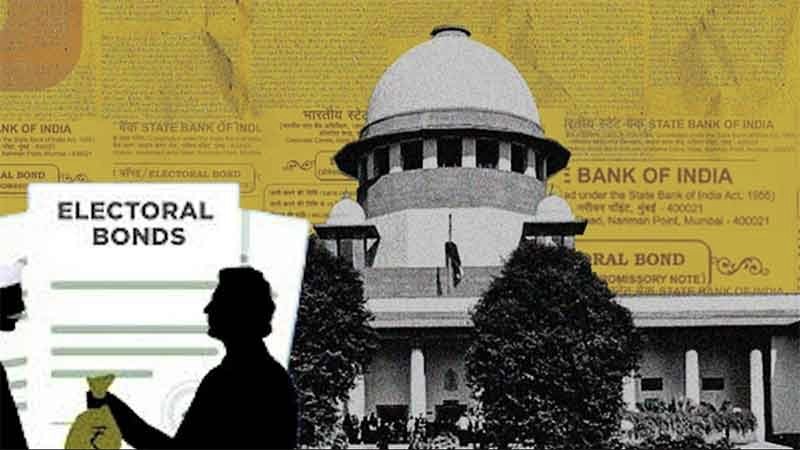Summary: The decision of the Supreme Court in the electoral bonds case represents an attempt at balancing conflicting fundamental rights by employing the double proportionality standard. In this piece, the author argues that the double proportionality standard, unlike the proportionality standard, must be read as a conjunctive test to prevent wholesale rejection of every impugned plenary legislation.
The Supreme Court’s (“SC”) verdict in the electoral bonds case will go down as one that profoundly shaped the electoral landscape of India. The judgement is particularly valuable for presenting the voters’ right to information and ability to exercise their electoral preferences meaningfully as a cornerstone of a democratic state. This judgement is also important for another crucial reason – laying down a concrete double proportionality standard for balancing equally placed fundamental rights.
In this piece, I argue that the double proportionality standard, unlike the proportionality standard, must be read as a conjunctive test to prevent wholesale “nuking” of every impugned plenary legislation. The piece consists of two parts. First, I describe the application of the double proportionality standard in the electoral bonds case. Second, I highlight the problems with a disjunctive double proportionality standard and make the case for a conjunctive application of the same.
The Double Proportionality Standard
In attempting to balance the right to information of voters under Article 19 and the right to informational privacy of political contributors under Article 21, the SC held that these rights would have to be balanced. The double proportionality standard is the measure through which this balance was sought to be evaluated. The test is notable for moving away from the earlier approach of attempting to read the conflicting fundamental rights in a manner that eliminates the conflict and ends up restricting the scope of the rights.
The SC, relying on CPIO v. Subhash Chandra Agarwal, held that when there is a conflict between rights where there is no clear hierarchy, the double proportionality test would have to be applied. This test has three prongs –
- Assessing whether the impugned measure is a suitable method for furthering both the conflicting rights (rational connection stage)
- Assessing whether the impugned measure is the “least restrictive and equally effective” method of achieving both the conflicting rights (necessity prong stage)
- Assessing whether the impugned measure has a “disproportionate impact” on the conflicting rights (balancing stage)
A bare perusal of the prongs of the double proportionality standard indicates that it resembles the proportionality standard except for the first prong of the latter – the legitimate aim stage.
However, this must not result in losing sight of a crucial distinction between the proportionality and the double proportionality standard. The proportionality standard attempts to analyse whether the restriction of a fundamental right by a legislative/executive measure is legitimate and reasonable, while the double proportionality standard reconciles the conflict between equally placed fundamentally rights which arises through a legislative measure. In other words, the proportionality standard reconciles the conflict between a fundamental right and a legislative/executive measure, while the double proportionality standard deals with a conflict between two fundamental rights. An impugned measure will fail the proportionality standard when it unfairly and excessively violates a fundamental right. On the other hand, it will fail the double proportionality standard when there is no satisfactory balancing of the conflicting fundamental rights. This difference between the standards means that they cannot be applied in the same manner, and the testing of an impugned measure under these standards will have to fulfil different thresholds.
Understanding the threshold of the double proportionality test becomes extremely important for two reasons. First, there is a wide scope for conflict between various fundamental rights, increasing the need for balancing between them. This possibility of conflict arises from the act that, barring Article 25, no other fundamental right has been subjected to other fundamental rights. When almost all the rights have been placed on the same level, it becomes crucial to develop a sound balancing method. Second, barring cases of infeasible and overly broad readings of fundamental rights, the avenue of limiting the scope of fundamental rights to eliminate conflicts may no longer be available to constitutional courts with the emergence of the double proportionality standard.
A Case for Conjunctive Double Proportionality
It must be noted that the proportionality standard is disjunctive in nature. This means that if an impugned measure fails to fulfil a single prong of the proportionality standard, it will fail the entire standard. The question that arises is whether the double proportionality standard, with its resemblance to the proportionality standard, must also be disjunctively applied. The manner in which the double proportionality standard has been applied in the electoral bonds case seems to indicate that the answer to the aforementioned question is in the affirmative.
In considering whether the electoral bonds scheme has a rational connection with the conflicting fundamental rights (right to information of voters under Article 19(1)(a) and right to informational privacy of political contributors under Article 21), the SC holds that the scheme has a connection with Article 21, but has “no nexus” with Article 19(1)(a). Then, the SC states that (para 163)
However, let us proceed to apply the subsequent prongs of the double proportionality analysis assuming that the means adopted has a rational nexus with the purpose of securing information about political funding to voters.
(emphasis supplied)
In saying that the Court must assume that the “means adopted” satisfy the rational connection prong for it to proceed to the “subsequent prongs of the double proportionality analysis”, there seems to be an indication that the double proportionality standard has a disjunctive character to its application. The SC uses the same disjunctive application that it employs for the proportionality standard for the double proportionality standard. An instance of this can be seen in the requirements that the SC has articulated for progressing from one prong to another for each standard. In order to move from the legitimate aim prong of the proportionality standard to its rational connection prong, the SC had to assume that the former had been met [the electoral bonds scheme was deemed to have failed the legitimate aim prong since it did not have a valid ground as laid down under Article 19(2) for restriction of voters’ rights under Article 19(1)(a)]. Akin to the need for an assumption that one prong of the proportionality standard had been fulfilled to move to the subsequent one, the SC had to make an assumption in moving from the rational connection prong of the double proportionality standard to its least restrictive means prong [the non-disclosure of information about political expenditure underlying the electoral bonds scheme was held to not have a rational nexus with the proclaimed goal of curbing black money]. Hence, the judgement seems to indicate that the double proportionality standard, like the proportionality standard, is also disjunctive in character – the failure to fulfil one prong of the standard will result in the impugned measure failing to pass the entire standard.
A disjunctive proportionality standard is ideal, since the inability of an impugned measure to fulfil any prong of the standard means that it is illegitimate, unconnected or excessive – all valid grounds for invalidating the same. However, as highlighted before, the double proportionality standard differs insofar as it seeks to analyse whether an impugned measure adequately balances conflicting fundamental rights. If the double proportionality standard is deemed to be disjunctive, I argue that every legislative/executive measure will fail the first prong of the standard, leading to a nuking of state action.
The double proportionality standard originated in Subhash Chandra Agarwal, in the conflict between the right to privacy of judges under Article 21, and the right to information of citizens under the RTI Act (which flows from Article 19). Justice Chandrachud, in his concurring opinion, held that these rights would have to be balanced in a manner that upheld their substantive content, while not disproportionately curtailing the conflicting rights. Citizens would have the right to information to the extent of exercising accountability and ensuring transparency, and judges would have the right to privacy without compromising the aforesaid principles. The crucial focus is on balancing the rights and upholding them simultaneously. If the first prong of the disjunctive double proportionality standard were to have been applied to this conflict, the RTI Act would have been held to have no rational nexus with the right to privacy of judges under Article 21, thus failing to balance the conflicting fundamental rights. Such an approach fails to recognize the possibility that legislative actions that seek to further a particular fundamental right may often inadvertently impinge on another fundamental right. The requirement here is not to nuke all legislative/executive measures that impinge on a fundamental right while seeking to further another fundamental right, but to assess whether the measure in question effectively balances the conflicting fundamental rights and does not unnecessarily or disproportionately curtail their content.
Another example of a conflict can be seen in the law requiring the disclosure of assets of the family members of a candidate contesting elections. This requires a balancing of voters’ right to information under Article 19(1)(a), and the family members’ right to privacy under Article 21. If a disjunctive double proportionality standard were to be applied, the law would be nuked for failing the first prong, since it does not have a rational nexus with furthering the right to privacy of the family members. Such an approach fails to consider the possibility of benami transactions, as well as family members holding assets for the candidates. This would be an inequitable outcome, since the voters’ right to information would be disproportionately curtailed. Again, the ideal approach would be to balance the conflicting fundamental rights and not give into a culture of nuking legislative and executive measures for failing a disjunctive double proportionality standard.
It is due to these limitations of a disjunctive double proportionality standard that the need for a conjunctive application arises. A conjunctive application means that the impugned measure will have to be checked on all the prongs of the standard and a holistic assessment will have to be made. Unlike the proportionality standard, an impugned measure must be simultaneously tested on all the prongs of the double proportionality standard to ascertain whether it adequately balances the conflicting fundamental rights. The problem with the current form of the standard is that, though it intends to be a balancing exercise, it is not applied comprehensively and holistically to achieve the intended result. While the application of the double proportionality standard as it currently stands may have resulted in a favorable outcome in this case, there is a pressing need to ensure that a mechanical application of it is not used to nuke all affirmative legislative/executive measures that further a fundamental right, but minimally and inconsequentially impinge on another fundamental right. This may be achieved only when there is a conjunctive application of the double proportionality standard in its future jurisprudence.
Kanishk Srinivas is a third-year student at NLSIU, Bangalore, and an analyst for LAOT.
[Ed Note: This article has been edited by Sukrut Khandekar and published by Harshitha Adari from the Student Editorial Board.]





